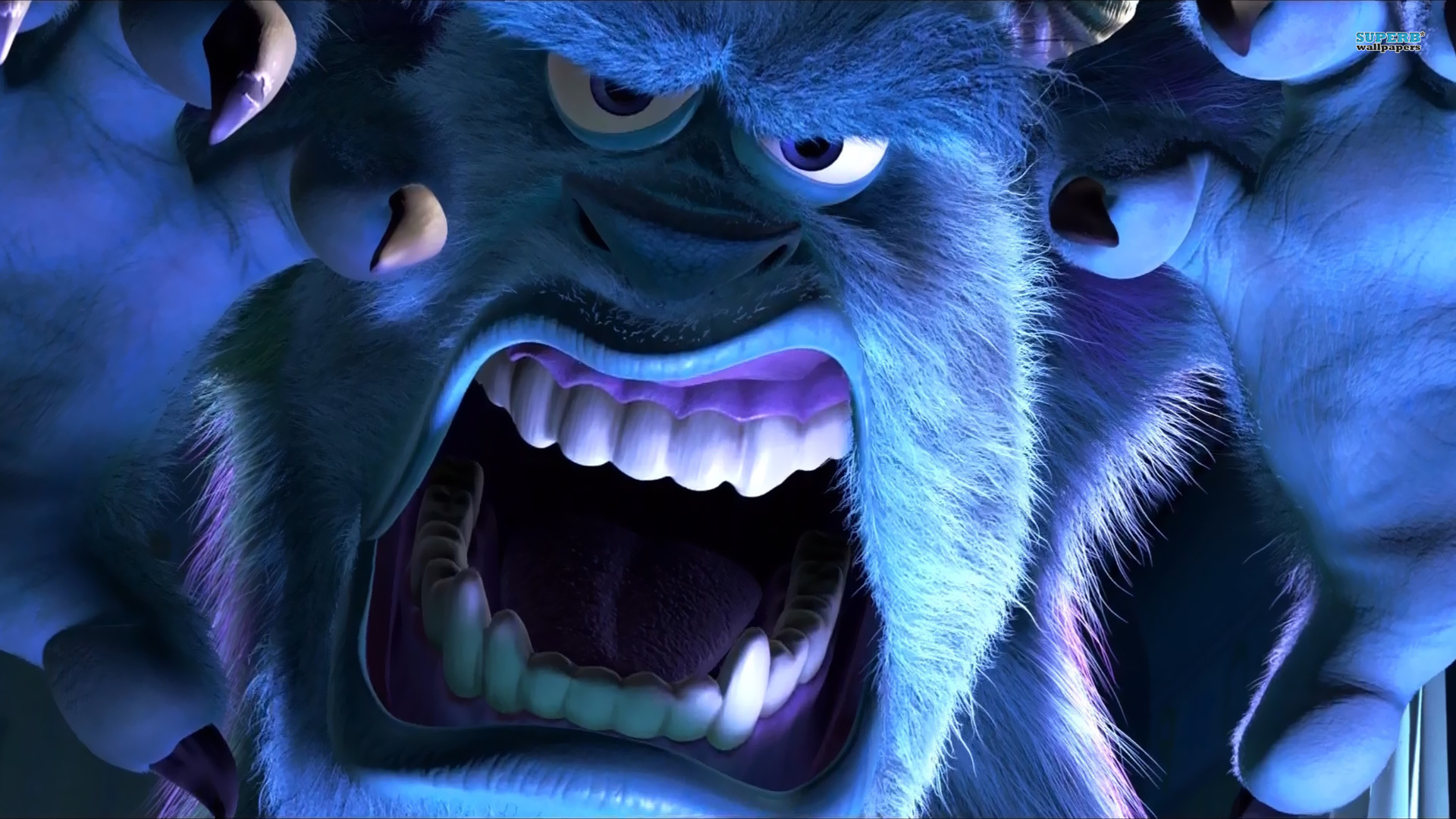Pixar’s fourth feature film has been unfairly overlooked for years despite its value exponentially appreciating since its release. Monsters, Inc.‘s prescient message about corporate greed—encapsulated in the children-scream-inducing factory which fuels a monster city—is unmistakably more relevant today, and in the last few years, than it was in 2001. That critique, while integral to the story’s overarching themes, never comes off as heavy-handed—as it is in other Pixar films, particularly Wall-E—and its ghoulish characters and interior corporate world are infinitely more endearing and nuanced than like-minded competitors likeShrek and Wreck-It-Ralph.
Monsters, Inc. perfectly juggles Pixar’s cornerstone touches (anthropomorphized characters, elaborate make-belief worlds, silly yet sophisticated humor) within the rubric of a scrupulously refined narrative arc. Unlike, say, the preciousness of Wall-E‘s leads, Sully’s (John Goodman) modesty about his natural scaring talents and moral instinct are never glorified, and his relationship to the sarcastic and neurotic Mike Wazowski (Billy Crystal) cleverly strays from the typical straight-man/funny-man dynamic, instead emphasizing a close-knit, fraternal work relationship that’s immutable even after the trials and tribulations presented by the cutesy, mischievous Boo (Mary Gibbs), their evil arch nemesis Randall (Steve Buscemi), and their equally twisted boss, Waternoose (James Coburn).
Pixar’s legacy is founded on the originality of their high concepts, and Monsters, Inc. is no exception; in fact, perhaps one of the film’s finest achievements is taking a central idea—closet-hiding monsters scare children into fits of screaming, the sounds of which are then bottled as a natural source of energy—to rewarding ends. The introduction is a beguiling example of folklore serving as the story’s building blocks for a much more nuanced diegetic logic. The film begins with a child in bed, peeking out at the tentacled creature creeping out of his closet. But the monster’s clumsiness reveals the artifice: He’s actually in a simulated training ground being taught how to scare and the child was all along an animatronic dummy. It appears that monsters have had increasing difficulty arousing genuine scares in our world’s newly apathetic children. The rest of the scene whizzes by checking off expository elements one by one so as to gracefully introduce protagonists and Monsters, Inc. star employees, Sully and Mike. While the rest of the film never contains as much narrative precision as its opening, it’s a thoughtfully constructed story that, typical of the preferred Pixar method, has clearly been through hundreds of revisions.
And while the high premise serves as a blatant allegory for blind corporatism (if it even qualifies as an allegory, though, when the diegesis operates with uncanny verisimilitude, considering we have our own real-life monsters), the film also carries with it the anxieties of any entertainment production house, Pixar included. The company’s ethos, its approach to nurturing employee creativity, and its hospitable work environment are the infamous “benefits of the job” that are part and parcel of the company’s mythmaking as every animator’s dream job. Equally publicized are the creators’ blood-and-sweat struggles in developing and finishing epic, long-term creative projects. The growing weariness of children and their inability to be scared by monsters (and by film’s end, their inability to be entertained) aren’t unlike the growing demands of audiences, who expect more and more with every new film. It’s not a perfect analogy (for example, Pixar doesn’t treat its viewers like infectious contaminants, at least not to common knowledge), but it does depict the soul-crushing nature of corporatism as something that can be replaced with better organizational models that promote corporate social responsibility and employee satisfaction. Sully’s creative problem solving of Monstropolis’s energy crisis—starting a new, nicer, gentler company in the place of the old Monsters, Inc. wherein the sounds of laughter are bottled, instead of screams—is symbolic of Pixar’s own entrepreneurial and creative origins and its groundbreaking work in animation and children’s cinematic storytelling.
Image/Sound:
This new five-disc Ultimate Collector’s Edition really only adds a 3D option to the previous Blu-ray edition of the film released in 2009; in terms of image quality, the quality remains the same. While it’s a meticulously cleaned, eminently crisp transfer, its technical perfection tends to diminish the vibrant warmth of the extensive color palette at play in Monstropolis, resulting in a noticeable flatness. This makes the then-revolutionary, now-outdated achievements in digital animation that much more apparent, particularly in the shiny, slick surfaces of its many scaled creatures, and especially when it comes to the realistic texture we now expect from Pixar’s recent efforts. But for the most part, the tiny animated nuances that Pixar is known for (Sully’s remarkably detailed thin-hair fur, the huge range of textures and surfaces, the wear and tear of factory machines, the complex lighting and shadowing) are beautifully and sufficiently lit, and in the upgrade process were clearly treated with respect and diligence. Audiophiles will salivate over the new Dolby TrueHD 7.1 track that is this edition’s best technical treat. The new mix hits all the right spots with its directional-savvy soundscape that offers a new level of absorption into the fertile diegesis of the monsters’ world.
Extras:
Two of the shorts included in this package appear here in 2D and 3D (Partysaurus Rex and For The Birds). There are some games for children, including a tedious 100-question challenge that would sustain a child’s attention for all of 20 seconds. The most fascinating featurette is “Banished Concepts,” which includes the film’s first story outline draft and reveals a rather different narrative from the finished product. Sully isn’t the modest, nice-guy Scarer of the Month, but actually a loserish, self-conscious underdog who dreams of moving up the Monsters, Inc. corporate ladder from unglamorous factory worker to prestigious scarer—all in spite of his fear of children (in this particular version, the children aren’t toxic). In other words, Monsters, Inc. was originally about a dopey protagonist who wants to change his fate, and if that sounds familiar that’s because the original Sully blueprint is almost identical in character, mannerisms and even vocal inflections as Disney’s Wreck-It-Ralph. This featurette doesn’t provide any illuminating context about the studio’s renowned lengthy storyboarding process, but it does serve as an elegant before-and-after comparison that gives the viewer autonomy in interpreting and dissecting the many character and narrative arcs that cohere so tightly within the finished film’s internal logic.
Overall:
Pixar’s overlooked gem arrives in a worthwhile collector’s edition bursting with features and exceptional A/V presentation.

